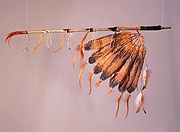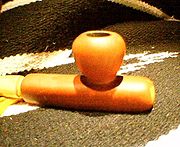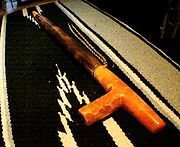.gif)
Calumet (pipe)
Encyclopedia

Native Americans in the United States
Native Americans in the United States are the indigenous peoples in North America within the boundaries of the present-day continental United States, parts of Alaska, and the island state of Hawaii. They are composed of numerous, distinct tribes, states, and ethnic groups, many of which survive as...
Nations. Traditionally it has been smoked to seal a covenant
Covenant (historical)
In a historical context, a covenant applies to formal promises that were made under oath, or in less remote history, agreements in which the name actually uses the term 'covenant', implying that they were binding for all time...
or treaty
Treaty
A treaty is an express agreement under international law entered into by actors in international law, namely sovereign states and international organizations. A treaty may also be known as an agreement, protocol, covenant, convention or exchange of letters, among other terms...
, or to offer prayers in a religious ceremony.
Etymology
"Calumet" is a NormanNorman language
Norman is a Romance language and one of the Oïl languages. Norman can be classified as one of the northern Oïl languages along with Picard and Walloon...
word, first recorded in David Ferrand's la Muse normande around 1625 - 1655. Its first meaning was "sort of reeds used to make pipes", with a wrong spelling for calume(l). It corresponds to the French word chalumeau 'reeds' (Modern French also 'straw', 'blowlamp'). Then, it was said by Norman-French settlers in Canada to describe the ceremonial pipes they saw in use among the First Nations
First Nations
First Nations is a term that collectively refers to various Aboriginal peoples in Canada who are neither Inuit nor Métis. There are currently over 630 recognised First Nations governments or bands spread across Canada, roughly half of which are in the provinces of Ontario and British Columbia. The...
people of the region. The name came into English-language usage as a general term for a ceremonial pipe, though in the cultures in question it is more common for a culturally-specific term to be used.
Overview
A common material for calumet pipe bowls is red pipestone or catliniteCatlinite
Catlinite is a type of argillite , usually brownish-red in color, which occurs in a matrix of Sioux quartzite. Because it is fine-grained and easily worked, it is prized by Native Americans for use in making sacred pipes such as calumets and chanunpas...
, a fine-grained easily-worked stone of a rich red color of the Coteau des Prairies
Coteau des Prairies
The Coteau des Prairies is a plateau approximately 200 miles in length and 100 miles in width , rising from the prairie flatlands in eastern South Dakota, southwestern Minnesota, and northwestern Iowa in the United States...
, west of the Big Stone Lake
Big Stone Lake
Big Stone Lake is a long, narrow freshwater lake and reservoir forming the border between western Minnesota and northeastern South Dakota in the USA. The lake covers 12,610 acres of surface area, stretching 26 miles from end to end and averaging around 1 mile wide, and at an elevation of 965...
in South Dakota
South Dakota
South Dakota is a state located in the Midwestern region of the United States. It is named after the Lakota and Dakota Sioux American Indian tribes. Once a part of Dakota Territory, South Dakota became a state on November 2, 1889. The state has an area of and an estimated population of just over...
. The pipestone quarries
Pipestone National Monument
Pipestone National Monument is located in southwestern Minnesota, just north of the city of Pipestone, Minnesota. It is located along the highways of U.S. Route 75, Minnesota State Highway 23 and Minnesota State Highway 30....
have traditionally been neutral ground among warring tribes, as people from multiple nations journeyed to the quarry to obtain the sacred pipestone.
A type of herbal tobacco, or a mixture of herbs was usually reserved for special smoking occasions, with each region's people using the plants that were locally considered to have special qualities or a culturally condoned basis for ceremonial use.
Some northern Sioux people used long, stemmed pipes for ceremonies while others such as the Catawbas in the southeast used ceremonial pipes formed as round, footed bowls with a tubular smoke tip projecting from each cardinal direction on the bowl.
Ceremonial use

Native Americans in the United States
Native Americans in the United States are the indigenous peoples in North America within the boundaries of the present-day continental United States, parts of Alaska, and the island state of Hawaii. They are composed of numerous, distinct tribes, states, and ethnic groups, many of which survive as...
cultures, with the style of pipe, materials smoked, and ceremonies being unique to the distinct religions of those Nations.
In ceremonial usage, the smoke is believed to carry prayers to the attention of the Creator
Creator deity
A creator deity is a deity responsible for the creation of the world . In monotheism, the single God is often also the creator deity, while polytheistic traditions may or may not have creator deities...
or other powerful spirits. Lakota tradition has it that White Buffalo Calf Woman
White Buffalo Calf Woman
White Buffalo Calf Woman , a sacred woman of supernatural origin, is treated as a prophet or a messiah and is central to the Lakota religion. Oral traditions relate that she brought the extended Lakota nation of the Teton Sioux their "Seven Sacred Rituals".- Story :The traditional story is that,...
, brought the Chanunpa
Chanunpa
Chanunpa, or Chanupa, is the Sioux language name for the sacred, ceremonial pipe and the ceremony in which it is used.The Chanunpa is one means of conveying prayers to the Creator and the other sacred beings...
to the people, and instructed them in its symbolism and ceremonies.
According to oral traditions, and amply illustrated by pre-contact pipes in museums and tribal and private holdings, some ceremonial pipes are adorned with feathers, fur, human or animal hair, beadwork, quills, carvings or other items having significance for the owner. Other pipes are very simple. Many are not kept by an individual, but are instead held collectively by a medicine society or similar ceremonial organization.
Before the development of lighter cigarette tobacco, the smoke was too harsh to be inhaled traditionally by Native Americans in ceremonial use. Today in most peace pipe ceremonies the smoke is not inhaled.
Pipestone varieties

Clay - The Cherokee
Cherokee
The Cherokee are a Native American people historically settled in the Southeastern United States . Linguistically, they are part of the Iroquoian language family...
and Chickasaw
Chickasaw
The Chickasaw are Native American people originally from the region that would become the Southeastern United States...
both fashioned pipes made from fired clay
Clay
Clay is a general term including many combinations of one or more clay minerals with traces of metal oxides and organic matter. Geologic clay deposits are mostly composed of phyllosilicate minerals containing variable amounts of water trapped in the mineral structure.- Formation :Clay minerals...
that also employed small reed
Phragmites
Phragmites, the Common reed, is a large perennial grass found in wetlands throughout temperate and tropical regions of the world. Phragmites australis is sometimes regarded as the sole species of the genus Phragmites, though some botanists divide Phragmites australis into three or four species...
cane pipestems made from river cane. These pipes were made from aged river clay hardened in a hot fire.
Red Pipestone - Catlinite
Catlinite
Catlinite is a type of argillite , usually brownish-red in color, which occurs in a matrix of Sioux quartzite. Because it is fine-grained and easily worked, it is prized by Native Americans for use in making sacred pipes such as calumets and chanunpas...
is an iron-rich, reddish, soft quartzite
Quartzite
Quartzite is a hard metamorphic rock which was originally sandstone. Sandstone is converted into quartzite through heating and pressure usually related to tectonic compression within orogenic belts. Pure quartzite is usually white to gray, though quartzites often occur in various shades of pink...
slate
Slate
Slate is a fine-grained, foliated, homogeneous metamorphic rock derived from an original shale-type sedimentary rock composed of clay or volcanic ash through low-grade regional metamorphism. The result is a foliated rock in which the foliation may not correspond to the original sedimentary layering...
typically excavated from below groundwater level, as the stone erodes rapidly when exposed to the weather and outside air. Red pipestone was used by the Eastern Tribes, Western and Great Basin Tribes
Great Basin tribes
The Indigenous peoples of the Great Basin are the Native American peoples of the Great Basin inhabited a cultural region between the Rocky Mountains and the Sierra Nevada, in what is now Nevada, and parts of Oregon, California, Idaho, Wyoming, and Utah. There is very little precipitation in the...
, and the Plains Tribes
Plains Indians
The Plains Indians are the Indigenous peoples who live on the plains and rolling hills of the Great Plains of North America. Their colorful equestrian culture and resistance to White domination have made the Plains Indians an archetype in literature and art for American Indians everywhere.Plains...
, with sources of the stone in Tennessee
Tennessee
Tennessee is a U.S. state located in the Southeastern United States. It has a population of 6,346,105, making it the nation's 17th-largest state by population, and covers , making it the 36th-largest by total land area...
(South Central), Minnesota (Pipestone), and Utah
Utah
Utah is a state in the Western United States. It was the 45th state to join the Union, on January 4, 1896. Approximately 80% of Utah's 2,763,885 people live along the Wasatch Front, centering on Salt Lake City. This leaves vast expanses of the state nearly uninhabited, making the population the...
(Delta, Uinta). Sacred pipestone comes from Pipestone, Minnesota
Pipestone, Minnesota
As of the census of 2000, there were 4,280 people, 1,900 households, and 1,138 families residing in the city. The population density was 1,090.8 people per square mile . There were 2,097 housing units at an average density of 534.4 per square mile...
. The quarry itself is located just north of the town at the Pipestone National Monument
Pipestone National Monument
Pipestone National Monument is located in southwestern Minnesota, just north of the city of Pipestone, Minnesota. It is located along the highways of U.S. Route 75, Minnesota State Highway 23 and Minnesota State Highway 30....
. Today only people of Native American ancestry are allowed to quarry the pipestone from this quarry. The pipestone or catlinite from this quarry is softer than any other catlinite.

Horse
The horse is one of two extant subspecies of Equus ferus, or the wild horse. It is a single-hooved mammal belonging to the taxonomic family Equidae. The horse has evolved over the past 45 to 55 million years from a small multi-toed creature into the large, single-toed animal of today...
among the Plains Tribes.
Bluestone - a hard, greenish-blue quartzite stone from the southern Appalachian Mountains
Appalachian Mountains
The Appalachian Mountains #Whether the stressed vowel is or ,#Whether the "ch" is pronounced as a fricative or an affricate , and#Whether the final vowel is the monophthong or the diphthong .), often called the Appalachians, are a system of mountains in eastern North America. The Appalachians...
. After being worked, it takes on a decidedly greenish cast. This stone was used by several Eastern Woodlands tribes for pipemaking. Cherokee, Creek
Creek people
The Muscogee , also known as the Creek or Creeks, are a Native American people traditionally from the southeastern United States. Mvskoke is their name in traditional spelling. The modern Muscogee live primarily in Oklahoma, Alabama, Georgia, and Florida...
, and Chickasaw made pipes from bluestone. Several ancient Mississippi
Mississippi
Mississippi is a U.S. state located in the Southern United States. Jackson is the state capital and largest city. The name of the state derives from the Mississippi River, which flows along its western boundary, whose name comes from the Ojibwe word misi-ziibi...
an bluestone pipes have been discovered.
Salmon Alabaster - the Uncompahgre Ute
Ute Tribe
The Ute are an American Indian people now living primarily in Utah and Colorado. There are three Ute tribal reservations: Uintah-Ouray in northeastern Utah ; Southern Ute in Colorado ; and Ute Mountain which primarily lies in Colorado, but extends to Utah and New Mexico . The name of the state of...
made beautiful ceremonial pipes from salmon alabaster
Alabaster
Alabaster is a name applied to varieties of two distinct minerals, when used as a material: gypsum and calcite . The former is the alabaster of the present day; generally, the latter is the alabaster of the ancients...
mined in central Colorado
Colorado
Colorado is a U.S. state that encompasses much of the Rocky Mountains as well as the northeastern portion of the Colorado Plateau and the western edge of the Great Plains...
.

Wyoming
Wyoming is a state in the mountain region of the Western United States. The western two thirds of the state is covered mostly with the mountain ranges and rangelands in the foothills of the Eastern Rocky Mountains, while the eastern third of the state is high elevation prairie known as the High...
and South Dakota and used by the Shoshone
Shoshone
The Shoshone or Shoshoni are a Native American tribe in the United States with three large divisions: the Northern, the Western and the Eastern....
, Ute, and Plains Tribes for personal and ceremonial pipes. This stone was also used to carve sacred effigies and religious items.
Black Pipestone (South Dakota) - a soft, brittle, white on black marbled pipestone found in South Dakota and used by the Plains Tribes for ceremonial pipes.
Black Pipestone (Uinta) - an extremely hard black quartzite slate which has undergone metamorphic
Metamorphic rock
Metamorphic rock is the transformation of an existing rock type, the protolith, in a process called metamorphism, which means "change in form". The protolith is subjected to heat and pressure causing profound physical and/or chemical change...
compression and is found in the southeastern drainage of the Uinta Mountains
Uinta Mountains
The Uinta Mountains are a high chain of mountains in northeastern Utah and extreme northwestern Colorado in the United States. A subrange of the Rocky Mountains, they are unusual for being the highest range in the contiguous United States running east to west, and lie approximately east of Salt...
in Utah and Colorado. This stone was used by the Great Basin Tribes for war club
Club (weapon)
A club is among the simplest of all weapons. A club is essentially a short staff, or stick, usually made of wood, and wielded as a weapon since prehistoric times....
s and beautiful pipes that are jet black with a high gloss when polished. Stones which had tumbled down creeks and drainages were always selected, since these stones typically contained no cracks or defects.
Traditional pipemaking tools

Bow drill
The bow drill is an ancient tool. While it was usually used to make fire, it was also used for primitive woodworking and dentistry. It consists of a bearing block or handhold, a spindle or drill, a hearth or fireboard, and a simple bow...
s that used hard white quartz
Quartz
Quartz is the second-most-abundant mineral in the Earth's continental crust, after feldspar. It is made up of a continuous framework of SiO4 silicon–oxygen tetrahedra, with each oxygen being shared between two tetrahedra, giving an overall formula SiO2. There are many different varieties of quartz,...
points which, when combined with water, could bore out even the hardest of pipestones.
Early Native Americans employed moistened rawhide strips rolled in crushed white quartz and stretched with a bow handle to shape and rough the pipes. The efficiency of such bow stone saws in cutting and slabbing a large piece of red pipestone is quite surprising given their seeming simplicity. Pipes were also shaped and roughed with hard sandstone
Sandstone
Sandstone is a sedimentary rock composed mainly of sand-sized minerals or rock grains.Most sandstone is composed of quartz and/or feldspar because these are the most common minerals in the Earth's crust. Like sand, sandstone may be any colour, but the most common colours are tan, brown, yellow,...
s, afterward polished with water, then sanded with progressively finer and finer abrasive
Abrasive
An abrasive is a material, often a mineral, that is used to shape or finish a workpiece through rubbing which leads to part of the workpiece being worn away...
grit and animal hide, finally being rubbed with fat
Fat
Fats consist of a wide group of compounds that are generally soluble in organic solvents and generally insoluble in water. Chemically, fats are triglycerides, triesters of glycerol and any of several fatty acids. Fats may be either solid or liquid at room temperature, depending on their structure...
or facial oils to complete polishing.

